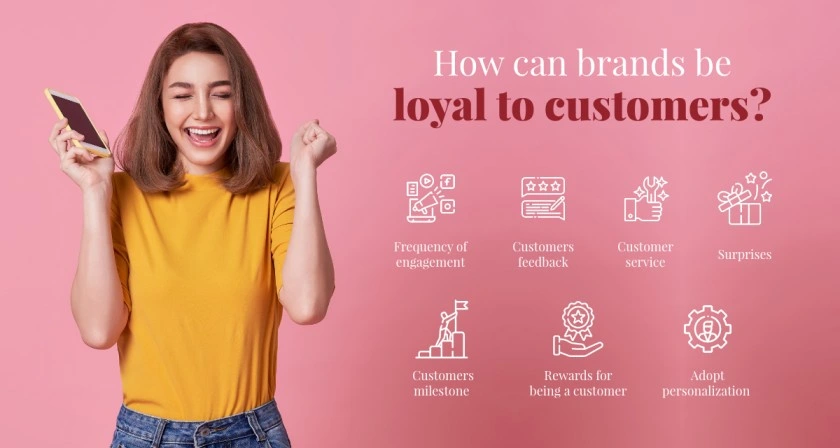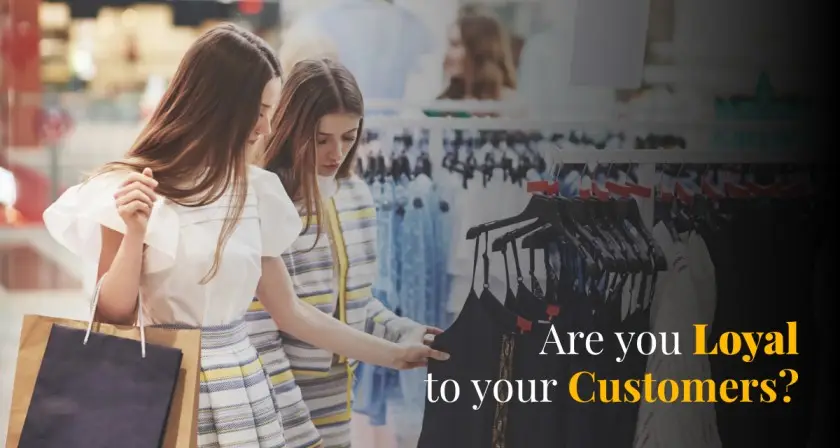Loyalty motivates customers to stay connected with a brand. Almost every brand is launching a loyalty program to drive customer retention. However, a customer loyalty program cannot succeed if it is one-sided.
Customers expect more than just monetary rewards. Just like their loyalty, customers expect brands to be loyal to them. Successful brands ensure they win the hearts of their loyal customers.
Why Does Showing Loyalty to Customers Matter?
In a survey, 67% of customers said a good online reputation is insufficient to retain them. They need to trust the brand behind a product or service to make repeat purchases. Today, buyers switch brands based on the brand’s statement or stand on social causes. TOMS’ is a great example of winning the customer’s trust by fulfilling its brand mission. The brand’s mission is ‘improving lives with the business,’ and it’s regularly working towards it by donating one-third of its net annual profits to grassroots charities. Loyalty programs help brands win trust through constant communication with customers in different instances.
The term “price-loyal” was coined for customers who only chose low-cost brands. They switch brands if the price goes up. Brands want these customers to become loyal to their brand instead of price. And to win customer loyalty, brands need to be loyal too. The best step to show loyalty to customers is through loyalty programs.
Customers perceive loyalty as a give-and-take deal. When brands go out of their way to improve customer experience, they perceive it as a sign of loyalty. And customers reciprocate this by frequent repeat purchases and more engagement with the brand. Therefore, staying loyal to customers plays a big role in the overall growth of a brand in terms of customer engagement, revenue, and market position.
How Can Brands Be Loyal to Customers?

1. Frequency of Engagement
Brands typically focus on increasing customer interaction through loyalty programs. While this is important, interaction must occur from both sides for it to be valuable. Consistently engaging with customers can help brands form an emotional connection. The best way to engage with customers without overbearing is by sending notifications or emails at calculated intervals.
Customers feel a sense of belonging when a brand informs them about new products or asks for their feedback. Regular interaction also personifies the brand. Brands can interact with customers through social media, app notifications, loyalty programs, or community spaces built by the brand. The more customers feel like part of the brand, the more positive their association becomes.
2. Value Customers and Their Feedback!
Loyalty programs, social media interactions, and reviews on multiple platforms give brands a good idea about what customers are talking about their products.
With loyalty programs in action, brands can gather essential feedback by rewarding them with gifts or points. To show loyalty toward customers, brands can work on their feedback.
3. Enhance Your Customer Service
Brands should respond to customer queries and issues. 24 X 7 customer support can show that brands care about customers and want the customer’s journey to be smooth. Brands can integrate chatbots with their apps and loyalty programs to ensure round-the-clock assistance.
In addition to this, brands should expand their customer support to social media platforms too. Responsiveness of a brand on social channels has now become critical as customers are using social media platforms actively at different stages of interaction with a brand. Gathering feedback, and addressing concerns and product-related issues as and when they are highlighted on social media provides customers more confidence in a brand.
4. Surprises or Perks When Not Expected
Incentives on special occasions are expected & common. Most brands offer discounts or free products to loyalty program members during holidays.
Instead of waiting for the holiday season, brands can surprise loyal customers by giving them rewards at unexpected times. Getting rewards on a regular day brings a smile to your customer and connects the brand emotionally. By doing this, brands show customers that their loyalty is being recognized.
5. Celebrate Customer Milestone
Customer journey mapping is one of the best ways to optimize the customer experience across all touchpoints. A customer journey map tells the complete story of the customer’s actions from joining the brand to the existing day. In addition, this map can help businesses recognize the milestones customers achieve. These milestones could include —the number of years with the brand, the number of products purchased, the amount spent with the brand, and time spent on the brand’s app or website.
When brands celebrate these milestones with an email or SMS acknowledgment, if not rewards, customers are motivated to engage more with the brand.
For example, brands can send a celebratory email to a customer for completing five years with the brand. Adding a reward for these customers adds delight to this milestone.
6. Rewards for Being a Customer, Not for Spending Money
Often loyalty programs are centered around the process of rewarding customers for performing an action. Unfortunately, this often leaves the impression that the brand values the money customers spend instead of the customers themselves. This leads customers to question a brand’s loyalty. To avoid this scenario, brands can give complementary or experiential rewards to customers.
Instead of offering the same coupons or discounts, brands should offer rewards that customers favor. For example, brands can provide customers with movie coupons, vacation coupons, or game tickets based on their preferences. Brands can also offer complementary services to loyal customers. An entertainment brand offering food coupons or travel coupons are some examples.
7. Adopt Personalization
77% of consumers pick, recommend, and pay more for brands that offer personalized services or experiences. Businesses collect a vast amount of data that can be used to understand customer preferences. In addition, brands can find out more about customers using fun surveys, games, etc. Personalization in a loyalty program is critical in driving customer loyalty by reflecting the brand’s efforts toward customers.
8. Build on Customer Experience
Customer experience revolves around the level of satisfaction derived from individuals’ interactions with your organization, from the initial encounter to their transformation into loyal brand advocates.
Customers’ perception of your brand and the quality of its products or services has a significant impact on their decision to maintain loyalty or seek alternatives.
The critical components of an excellent customer experience encompass the following:
- The customer’s assessment of the organization and its offerings.
- The caliber of service delivered by the company.
- The encounter customers have with a particular product or service.
- The level of trust they place in the company.
A loyalty program is a highly effective approach for businesses to enhance customer loyalty. Such programs prove advantageous to both customers and companies as they reward customers and facilitate the development of personalized relationships, consequently bolstering brand recognition.
Additionally, loyalty programs contribute to increased repeat purchases by motivating customers to return for further rewards. Another crucial aspect that fosters customer loyalty is exceptional customer service. The quality of your product or service and the support provided greatly influence the overall customer experience.
Furthermore, the capability to capture real-time customer feedback holds significant importance in fostering customer loyalty. Numerous companies have recently embraced social media platforms like Facebook, Twitter, and Instagram as avenues for customers to leave feedback and reviews.
9. Gamification is Enticing
In human psychology, gamification taps into human psychology by stimulating reward-driven behavior and creating a strong desire to monitor progress and strive for new achievements. This dynamic establishes a compelling framework for fostering habit-forming repeat purchases. Customer loyalty places significant demands on customers as it necessitates their time, effort, and consistent commitment to choosing your offerings over competing alternatives. However, by leveraging gamification in the loyalty program, businesses can reap numerous benefits across different sectors, ultimately giving back to customers and finally showcasing their loyalty towards customers.
Making tasks more enjoyable and engaging boosts motivation and encourages individuals to strive harder to achieve their objectives. In educational settings, gamification enhances learning and retention by making the process interactive and enjoyable. Similarly, gamification drives improved productivity in the workplace by incentivizing employees to complete tasks efficiently. Additionally, it can foster customer loyalty and satisfaction by incorporating gamified elements into products or services. In health and wellness, gamification promotes better outcomes by motivating individuals to adopt healthier habits. Moreover, it fosters social interaction and a sense of community, benefiting those who may feel isolated or disconnected.
Conclusion
A significant part of building customer loyalty depends on how loyal the brand is to customers. A loyalty program can empower a brand to express its loyalty to customers in different ways, including rewards, personalized experiences, and more! What strategies do you employ to cultivate customer loyalty? Do you prioritize loyalty toward your customers? How do you engage and reward your customers to foster loyalty towards your brand?


